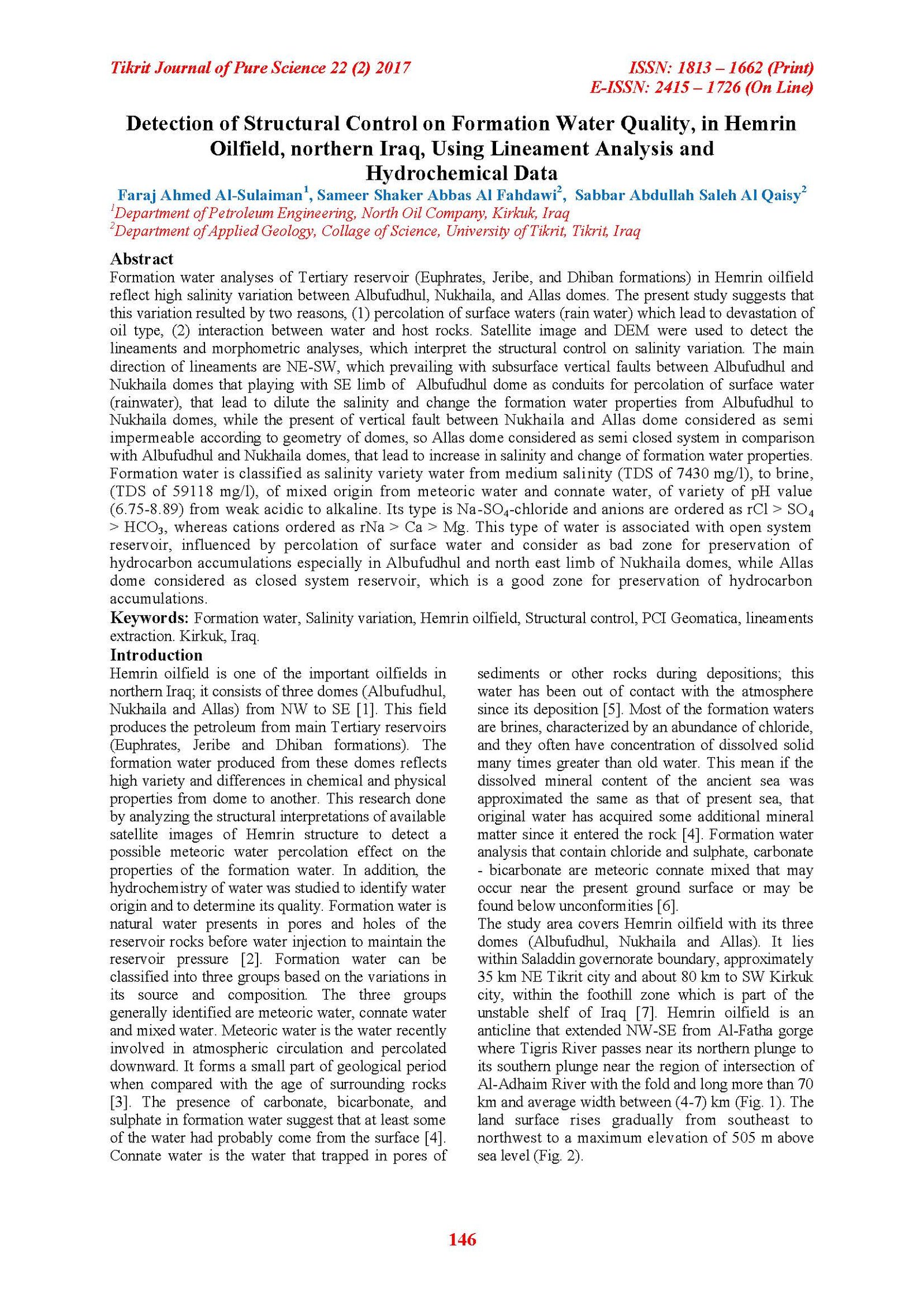Detection of Structural Control on Formation Water Quality, in Hemrin Oilfield, northern Iraq, Using Lineament Analysis and Hydrochemical Data
Main Article Content
Abstract
Formation water analyses of Tertiary reservoir (Euphrates, Jeribe, and Dhiban formations) in Hemrin oilfield reflect high salinity variation between Albufudhul, Nukhaila, and Allas domes. The present study suggests that this variation resulted by two reasons, (1) percolation of surface waters (rain water) which lead to devastation of oil type, (2) interaction between water and host rocks. Satellite image and DEM were used to detect the lineaments and morphometric analyses, which interpret the structural control on salinity variation. The main direction of lineaments are NE-SW, which prevailing with subsurface vertical faults between Albufudhul and Nukhaila domes that playing with SE limb of Albufudhul dome as conduits for percolation of surface water (rainwater), that lead to dilute the salinity and change the formation water properties from Albufudhul to Nukhaila domes, while the present of vertical fault between Nukhaila and Allas dome considered as semi impermeable according to geometry of domes, so Allas dome considered as semi closed system in comparison with Albufudhul and Nukhaila domes, that lead to increase in salinity and change of formation water properties. Formation water is classified as salinity variety water from medium salinity (TDS of 7430 mg/l), to brine, (TDS of 59118 mg/l), of mixed origin from meteoric water and connate water, of variety of pH value (6.75-8.89) from weak acidic to alkaline. Its type is Na-SO4-chloride and anions are ordered as rCl > SO4 > HCO3, whereas cations ordered as rNa > Ca > Mg. This type of water is associated with open system reservoir, influenced by percolation of surface water and consider as bad zone for preservation of hydrocarbon accumulations especially in Albufudhul and north east limb of Nukhaila domes, while Allas dome considered as closed system reservoir, which is a good zone for preservation of hydrocarbon accumulations.
Article Details

This work is licensed under a Creative Commons Attribution 4.0 International License.
Tikrit Journal of Pure Science is licensed under the Creative Commons Attribution 4.0 International License, which allows users to copy, create extracts, abstracts, and new works from the article, alter and revise the article, and make commercial use of the article (including reuse and/or resale of the article by commercial entities), provided the user gives appropriate credit (with a link to the formal publication through the relevant DOI), provides a link to the license, indicates if changes were made, and the licensor is not represented as endorsing the use made of the work. The authors hold the copyright for their published work on the Tikrit J. Pure Sci. website, while Tikrit J. Pure Sci. is responsible for appreciate citation of their work, which is released under CC-BY-4.0, enabling the unrestricted use, distribution, and reproduction of an article in any medium, provided that the original work is properly cited.
References
[1] Al Naqib, K.M., 1959. Geology of the southern area of the Kirkuk liwa. 2nd Arab Petroleum Cong. Pub., London.
[2] Collins, A. G., 1975. Geochemistry of Oilfield Waters. Development in petroleum science, Elsevier Sci. Publ. Co., Oxford - New York, 464P.
[3] Whit, ED. E., 1957. Magmatic, connate, and metamorphic waters: Geol. Soc. Amer. Bull. 68, 1659-1682.
[4] Georgie WJ; Sell, D; Baker, MJ., 2001. Establishing Best Practicable Environmental Option Practice for Produced Water Management in the Gas and Oil Production Facilities, SPE 66545, presented at the SPE/EPA/DOE Exploration and Environmental Conference, San Antonio.
[5] Kharaka, Y. K. and Carothers, W. M., 1986. Oxygen and hydrogen isotope geochemistry of deep basin brines. In Handbook of Environmental Isotope Geochemistry (eds. P. Fritz and J. Ch. Fontes) Vol. 2, Elsevier, North Holland, pp. 305-360.
[6] Joel O.F; Aajuoyi, C, A; Nwokoye, C. U., 2010. Characterization of formation water constituents and the effect of fresh water Dillution from land rig Location of the Niger Delta, Nigeria, Journal of applied science Enviroment and Management, June.
[7] Buday, T. and Jassim, S. Z., 1987. The Regional Geology of Iraq. Vol. 2: Tectonic, Magnetism, and Metamorphism, Publication of GEOSURV, Baghdad, Iraq, 352p.
[8] Lateef, A. S., 1975. Report on the Regional Geological Mapping of Hemrin Range from Al-Fatha to Ain-Layla, unpub. rep., Geosurv. lib., No 772, Baghdad.
[9] Al Ward, A.H., 2012. study structural analysis and its Tectonic indication of Albufudhul dome in northern Hemrin anticline.Unpub. M. Sc. Thesis, College of Science, University of Tikrit. 124P(In Arabic).
[10] Al Miahy. D. S., 2004. Study of Tectonic and Structure for Makhul-Hemrin subzone /North East Iraq. Unpub. M. Sc. Thesis, College of Science, University of Basra, 71P (In Arabic).
[11] Buday, T., 1980. Stratigraphy and Paleogeography. In: I. I. M., Kassab;S. Z., Jassim (Editors): The Regional Geology of Iraq, stratigraphy and palegeography, Volume 1, Dar Al-Kutib Publishing House, Univ. of Mosul, Iraq, p 445.
[12] Jassim, S. Z., and Goff, J. C., 2006. Geology of Iraq. Dolin, Prague, Czech Republic, 341p.
[13]Deikran, D. B., 2003. The study of finite strain in the Hemrin North Fold central Iraq. Unpub, Ph. D. Thesis, College of Science, University of Baghdad. 178 P.
[14] PCI Geomatica 2001. PCI Geomatica user’s guide version 9.1, Ontario. Canada: Richmond Hill.
[15] El Hadani, D., 1997. Remote Sensing and Geographic Information Systems for the management and water research. Geo-Observer. The Thematic Report, 1: 28.
[16] Charon, J. E., 1974. Hydrogeological applications of ERTS satellite imagery. In: Proc UN/FAO regional seminar on remote sensing of earth resources and environment, Cairo. Commonwealth Science Council, 439-456.
[17] Edet, A. E., Okereke, C. S., Teme, S. C. and Esu, E. O., 1998. Application of remote sensing data groundwater exploration: A case study of the Cross River State, Southeastern Nigeria. Hydrogeology J. 6:394-404.
[18] Langmuir, D., 1997. Aqueous Environmental Geochemistry. Prentice Hall, USA, 600p.
[19] Al Khafaji, J. L. A., 2003. Hydrogeochemistry and hydrodynamics of oilfield brines of Cretaceous reservoirs in oil-fields–south Iraq. Ph. D. Thesis, College of Science. University of Baghdad. Unpubl. 210P. (in Arabic).
